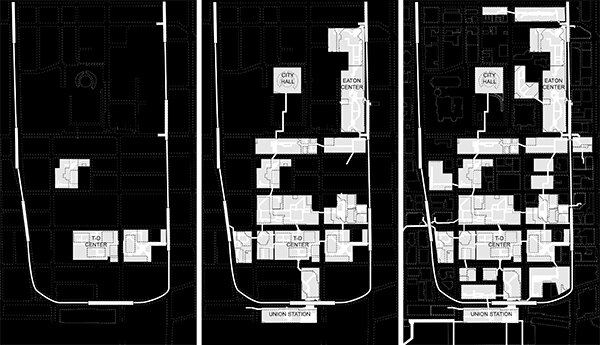ENDLESS ARCHITECTURE

Michael Piper and James Khamsi, “Endless Architecture: Accidental Manifestos for the Interior” in MONU #21 Interior Urbanism
1972 was the year I came to America, it was also the year the World Trade Center was finished and it was the year Learning from Las Vegas was published. And I think, what all those event implied together was that somehow … the age of manifestos seemed to be over … and since it seemed increasingly uncertain what should happen, one should look at reality, and describe cities and describe developments as they were taking place; and if anything, interpret rather than speculate how the future would look.
– Rem Koolhaas on Venturi + Scott-Brown (2006)
At this time when realism has superseded pipe dreams as the primary mode of urban imagination, pipe dreams have become realities. Capitalist development is no longer always punctual (discrete projects on discrete land) – it is proliferative (multiple projects melding into each other). Projects expand, gather and connect without recourse to the property lines or infrastructures (roads/freeways) that once kept buildings apart. The result is that the interior, once bound by architectural and proprietary containers, now has the capacity to grow infinitely. In both expanding suburban shopping malls and central commercial developments linked by a web of bridges and tunnels, the interior has grown to become an urban form.
We learned from Las Vegas, Manhattan and Atlanta that late 20th Century cities were disjunctive and a-compositional – suburban archipelagos of discrete buildings or urban grids of autonomous floorplates. While these conditions persist, new urban forms have emerged that can not be described with this punctual narrative. In a reversal of the methods advanced by Scott-Brown, Venturi and Koolhaas, the maverick urban developments of today are better understood by looking at critical urban projects from the 60’s. Such projects build fantasy from the real, a reworking of real estate into components of an endless interior architecture.
Critical projects in the 60’s, such Constant’s New Babylon and Archizoom’s No-stop City, were neither innocently bold enough to proclaim futures, nor humble enough to let reality dictate “how the future would look.” A critical fiction was produced by combining two distinct realities into a single narrative:
[Critique one: the contemporary city was a sprawling expanse of punctual structures]
+ [Critique two: Maniacal modernists had cottoned to the proliferative megastructure]
= [Fiction: the expansive megastructure at the size of the city]
These fictional urban forms, neither in awe of the present nor optimistic for the future, were vehicles for critiquing contemporary spatial production, but in doing so, unwittingly became blueprints for what new realities of cities would be.
To study this condition we have researched two examples of commercial building in Toronto that have taken these realist fictions and translated them into fanciful realities of an endless interior.
(1) Growing Malls: New Babylon is a manifesto for aggregative expansion. The building is a composition of materials assembled over time which is growing to the size of a city. Suburban malls in Toronto have expanded beyond their initial bounds. With a patchwork of additions, the aggregative hallways volumetric department stores show the potential of a boundless interior that synthesizes urban experience through contrasting interior spatial and material assemblages.
(2) Tunnels and Bridges: No-Stop City is a manifesto for connective circuitry. Discrete objects in urban territory can be linked by a private circuitry that does not engage traditional infrastructures of the city. The occupant experiences continuity and uniformity, a world without differences. Toronto’s downtown core is linked by a network of tunnels and (more recently) bridges that create a continuous commercialized interior experience that flows over proprietary distinctions and infrastructural obstacles.